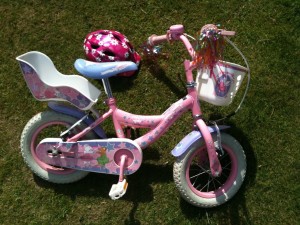Riding a bike
I talk about learning all the time, it’s often learning situated in classrooms or in the workplace. Of course, I see examples much closer to home too.
My little girl is 5 years old. She started school in January. She hasn’t stopped learning since the day she was born and whilst that might be true for all of us, a child’s development is so much more dramatic. Every day she learns something new, every day she applies some novel approach or improved understanding, every day she discovers something different.
It is fascinating to watch this process first-hand and to play some minor part in it. Often I just watch as she interacts with her friends, plays on her own or does something with one of the family. I know that much of Scarlett’s behaviour and approach to life is a reflection of my and her mother’s. We are modelling attitudes all the time either consciously or subconsciously. It can be a terrible responsibility especially when I see my worst habits reflected back to me through her. It is of course, a tremendous privilege at the same time.
A recent event has highlighted my role as “teacher” to my daughter: Scarlett’s attempts to ride a bicycle without stabilisers. Her bike is probably a little too small for her now and yet we bought it for her when she was too young. It has had stabilisers since the day it came home from the shop. I’ve always wondered about their effectiveness because they teach a child that it is unnecessary to balance and that you don’t have to put your feet down when the bicycle stops. When you’re learning to cycle these are fairly catastrophic assumptions.
So today I took off the stabilisers and we set off for the Park. Although Scarlett has ridden her scooter to school all year, I wasn’t going to let her attempt to ride the bike solo straightaway.
Riding a bike requires three skills:
- Understanding the mechanics
- Developing balance
- Having confidence
Although we might take these things and this process for granted, for a 5-year-old each step is a real challenge.
She needed to understand the propulsion of pedalling, the effect of the brakes and the sensitivity of the steering. These things aren’t academic – understanding the basis for movement is fundamental to moving. Initially her understanding might be shaky but eventually she’ll do it and deconstruct, able to make sense of the information in the context of her new experience.
She needs to learn how to shift her weight and move her centre of gravity to keep the bike upright, and later how to take corners. What’s more, she needs to figure out how to do this while pedalling. There’s a physical element to making sense of the knowledge.
Finally, and perhaps most importantly, she needs to develop the confidence to challenge what she know and try something new. She’s learnt that the stabilisers keep her up; now she has to prove herself wrong. It’s not just bravery, it’s turning a worldview upside down.
And so my role as teacher, isn’t just to explain what to do and stand back. Nor can I do it for her. No, the explanation was just the start. Some of these things she learns by simple repetition – holding the brakes while she steadies the bike in preparation to push off, some she learns through experimentation, some she learns through a leap of faith. My most valuable contributions are a steadying hand and words of encouragement.
Being right next to her is absolutely essential until that time when she has enough confidence to go it alone. Only when she feels safe will she feel prepared to take responsibility for our own learning and even then, when she falls, which she inevitably will, I will be there encouraging her to try again.

